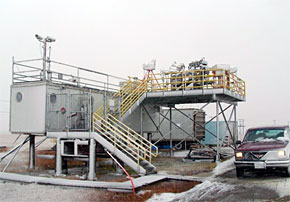User Facility Improvements Continue at North Slope of Alaska Locale
Published: 15 April 2005

Two things are critical for conducting scientific research: adequate equipment and power. This is especially true in the Arctic, where average winter temperatures hover around -30 degrees Celsius, and access to additional resources is limited. After experiencing crowded working conditions during complex field campaigns last year, followed by several power outages this past winter, operations staff at the ARM Climate Research Facility’s North Slope of Alaska (NSA) locale began implementing measures to improve the situation. Part of the solution is contained in a new emergency response plan, which addresses various emergency conditions. The other part is focused on upgrading various infrastructure capabilities.
Power outages at the NSA Barrow site this past winter spurred an investigation into potential upgrades for the power line serving the NSA Barrow site, which also feeds power to equipment used by National Oceanic and Atmospheric Administration (NOAA), U.S. Geological Survey, and nearby National Science Foundation projects. Operations staff discovered that not only is the current power feed several decades old, but it also makes use of obsolete equipment for which replacements are not readily available. They also found the feed is being operated closer and closer to maximum capacity. To better prepare for future power outages and other mishaps, the site operations manager procured a snowblower and backup generator, and prepared an emergency response plan that summarizes response actions in the event of power failures, fires, floods, and medical emergencies. In the longer term, the plan involves replacing the power line to the “Great White” instrument shelter at Barrow and the nearby facility operated by NOAA. Discussions are underway with the affected organizations to see if an agreeable arrangement can be made to share the costs of the needed modernization and capacity upgrade.
From a logistical standpoint, a number of steps are being taken to handle additional users and instruments, and alleviate overcrowding. Design modifications to the existing instrument platform in Barrow were completed in fall 2004 to accommodate two new insulated shelters for housing additional data systems. The shelters, built to withstand tropical heat, demonstrated their utility in cold weather during the Mixed-Phase Arctic Cloud Experiment, and are scheduled to arrive in Barrow this summer. A laboratory area within the site maintenance building is also under development to provide even more room for researchers and their equipment. And lastly, operations staff eagerly anticipate the arrival of a new four-wheel drive crew-cab flatbed pickup this summer, as well as the possibility of access to a light-duty pickup through an agreement with the Barrow Arctic Science Consortium.
The ARM Climate Research Facility is a DOE Office of Science user facility. The ARM Facility is operated by nine DOE national laboratories, including .
Keep up with the Atmospheric Observer
Updates on ARM news, events, and opportunities delivered to your inbox
ARM User Profile
ARM welcomes users from all institutions and nations. A free ARM user account is needed to access ARM data.


















